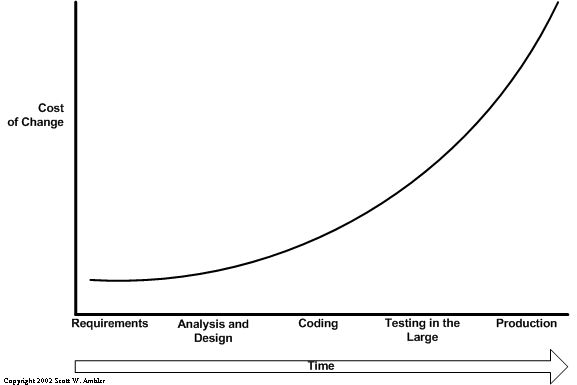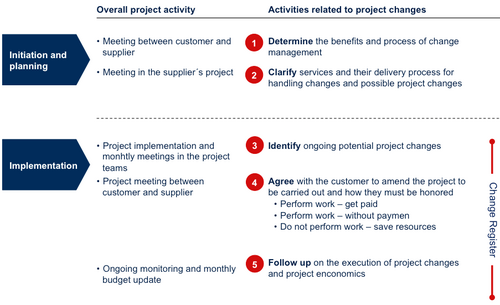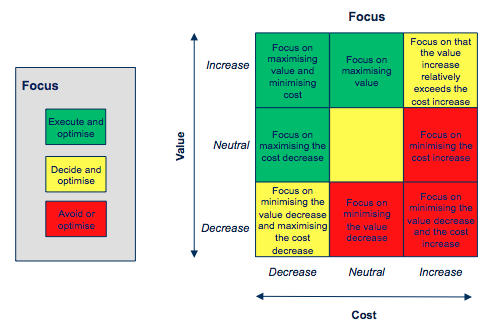Management of Project Change
(→Cost of changes) |
(→Cost of changes) |
||
| Line 10: | Line 10: | ||
= Cost of changes = | = Cost of changes = | ||
| − | [[File:Traditional cost of change curve 2. | + | [[File:Traditional cost of change curve 2.gif]] |
= Process of project changes = | = Process of project changes = | ||
Revision as of 17:55, 21 September 2015
Management of project change is to handle changes in a company´s projects and is a very difficult thing to handle. The changes may occur because of new changes in the organization or maybe the customers has requested a change in the product or a new service. This article will address product change and new services. An example of a project change could be a company that are building an administration building and six months in the process the customers suddenly also want a underground parking. Now the company has to change the project so the additional cost can be minimized and the project still can be built on time. To handle such changes require experience and planning.
In this article, the following topics will described to give the reader a better understanding how project changes can handled in the following order:
- Cost of project changes
- Process of project changes
- Project change decision process
- Discussion
- Conclusion
Contents |
Cost of changes
Process of project changes
As mentioned earlier, there are many different ways to handle project changes. Each company has their own model for project change and to illustrate how project changes can be handled, a model from a company will be used to describe how the project change can be made. In this case the model from the company Sveko will be used, which is a consultative construction company. The model can be seen at figure 1.
The model is divided into two big phases that are:
- Initiation and planning
- Implementation.
The initiation phase will begin before the start of project to ensure that the expectations of potential project changes are aligned with the customer and supplier. The initation phase has two overall activities there are marked in the two red circles with a 1 and 2.
1) In the first activity there will be a meeting with the customer and the supplier. In this activity it is very important that the benefits and process of change management will be determined. One of the biggest mistakes in projects is when expectations are not attuned to possible future changes in a project. When there is consensus and clarity of the possible future project change, the project group meeting will find place in the second activity.
2) In the second activity the supplier has now determined the benefits and process of change management with the client. Therefore the company will have a meeting with the project team to clarify services, delivery process and possible project changest that adresses the customers need that was determined in activity one.
When activity one and two are completed, then phase two can be startet.
The implementation phase will begin when the project starts and in this phase potential project changes will be identify and afterwards the customer will make the final desicion on the change to be made. Finally, there will be continuous follow up on the project. The initation phase has three overall activities there are marked in the three red circles with a 3, 4 and 5.
3) In the third activity the ongoing potential project changes will be identified and there will be monhtly meetings in the project teams. As the project goes ahead there will continually be possible project changes and these will be discused in the project teams. To have an overview of all the posible project changes a change register will be used as seen on figure 1. All the information about the different types of changes will be listed in the change register and be used on the meetings and for the customer.
4) In the four activity there will be a meeting between the customer and the supplier where the potential project changes will be showed to the client. Here it will be assessed if the project changes has to be implemented or not. It can be very diffucult to choose between the different types of potential project changes and therefore the desicion making about a project change will be detailed described in the section xxx.
5) In the five the activity there will be follow up on the execution of the project changes and its economics and estimation of time. Furtheremore there will be monitoring and monthly budget updates thus that the estimated time and cost will be met.
Project change decision process
As mentioned earlier, it can difficult to choose between which project changes that should be made. Often is there a tight deadline and therefore it is not necessarily all project changest that can be performed. Therefore it is important to choose the most important project changes. The model to handle the decision proces can be seen at picture 2.
The model is divided into three phases that are:
- Project changes
- Value for money (value and cost)
- Effect
The Project changes phase In the first phase it must be assessed what the possible project change we should consider to implement is and why we should implement it.
The value for money (value and cost) phase In the second phase it must be assessed what value the change will bring and what it will cost and how the focus should be to ensure maximum value for money for the change. Figure 2 shows a matrix where the value can be seen at the y-axis and the cost been seen at the x-axis. The purpose of the matrix is to decide what changes that are most important seen from a value and cost point of view. The best place to be in the matrix is in the green box in the upper left corner where the value will be increased and the cost will be decreased. The place we not would be is in the red box in the lower right corner where the value will be decreased and the cost will be increased.
The effect phase In the third phase it must be assesed what the effect of the change is and if it does deliver added value in relation to the project objectives for the stakeholders. The effects has to create value for the project and therefore it is positive thing if the project change contains most multiple effects as possible. The project change should result in an effect that benefits the project. Furthermore it is positive if the project change are affecting more stakeholders in a good way than before the change of the project.
Different types of effect and stakeholders that a project change can effect can be seen below.
Effect (e.g.)
• Time
• Quality
• Future proofing
• Sustainability
• Brand and image
• Health and Safety
• Etc.
Stakeholders (e.g.)
• The Client
• The Clients’ clients
• Users
• Authorities
• Suppliers
• Society
• Shareholder and investors
• Etc.
Discussion
Conclusion
References
http://www.agilemodeling.com/essays/costOfChange.htm http://www.wisegeek.com/what-is-product-change-management.htm http://www.computerweekly.com/opinion/Five-tips-for-managing-project-change-requests http://www.dummies.com/how-to/content/how-to-manage-project-change-requests.html http://cobaltpm.com/effective-project-change-management http://4pm.com/change-requests-4pm-com


